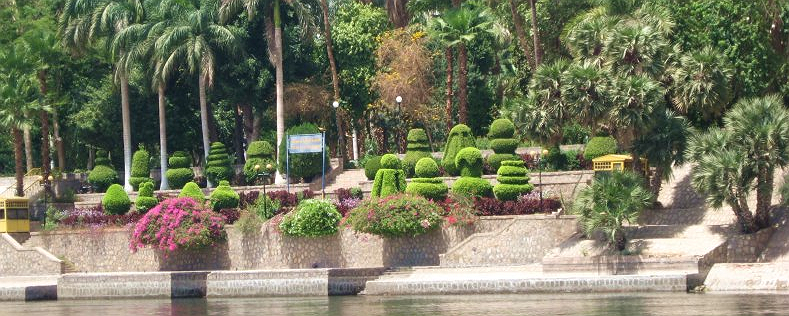Blog

The Nile Valley is best known for being the land of ancient Egypt’s legacy with all its temples, museums and monument. When you’re in Aswan, take a break from its historic attractions and escape your hectic schedule to appreciate a different side of it and pay a daytime visit to the peaceful haven of the botanical garden of Aswan.
Overview of the Island
The island is oval shaped and covers an area of 17 acres; a length of 650 meters and width of 150 meters. It’s located on the Eastern bank of the Nile, the opposite side of the city of Aswan and Elephantine Island.
The Island is divided into 27 basins by 4 vertical pathways and 9 horizontal pathways. All the pathways are pink granite paved and shaded with royal palms or Rosytoneas with their marble white stems.
History of Kitchener’s Island
The reason behind the name “Kitchener’s Island” is that during his military service in Sudan in 1899, Lord Horatio Kitchener took over this island and made it headquarter for leadership of his campaign and a place of rest as well and it became known as The Lord’s House. Lord Kitchener, who had a great deal of passion for plants, turned the island into the exquisite Aswan Botanic Garden. He imported rare exotic plants and palms from the Far East, India and other African countries.
Soon after the lord’s departure in 1928, the ownership of the island was transferred from the Ministry of Irrigation to the department of scientific researches of the Ministry of Agriculture who choose to turn the island into a natural greenhouse of tropical and subtropical plants.
What to Expect to Find in the Botanical Garden
There are 7 basic groups of plants and trees can be found in the Botanical Garden of Aswan:
Woody trees: such as ebony, mahogany and sandalwood.
Tropical fruits trees: such as papaya, avocado and mango.
Medicinal and aromatic plants: such as clove, basil, rosemary and mint.
Spice plants: such as chili, cinnamon and ginger.
Ornamental plants: such as jasmine, tulip and petunia.
Oleaginous plants: such as coconut palms and olive trees.
Palm group: such as coconut palms and date palms.
You’ll find a small botanical and aquatic museum, water filters, irrigation pumping station and a cafeteria to serve the visitors with a place for kids. Rare species of birds such as doves, crows and ravens can be seen there too.
How to Get There
A felucca ride from and back to your hotel is available for around $10 including entrance fees. The ride should not take more than 25 minutes. You can also take a one-way motorboat or local ferry ride.
The island has 3 entrances; the main entrance is located on the northern point of the island, another in the middle and another on the southern point. The best way to gain full perspective of the island and save strolling is to enter through the main entrance and stroll down all the way through to the southern point, where your felucca man will be waiting to pick you back to your hotel.





comments
No comments yet.